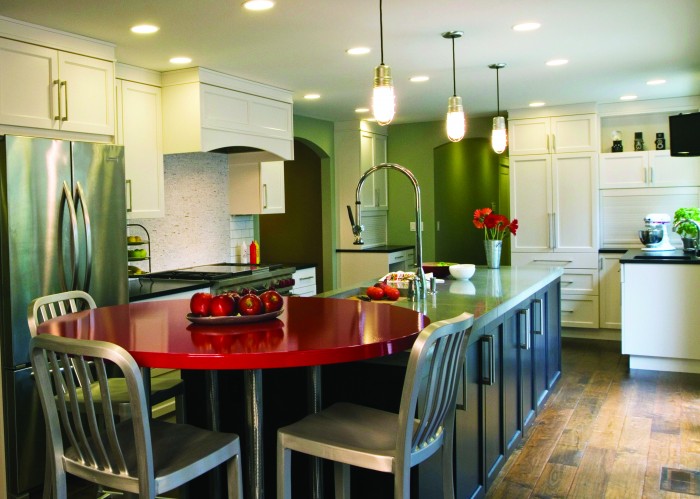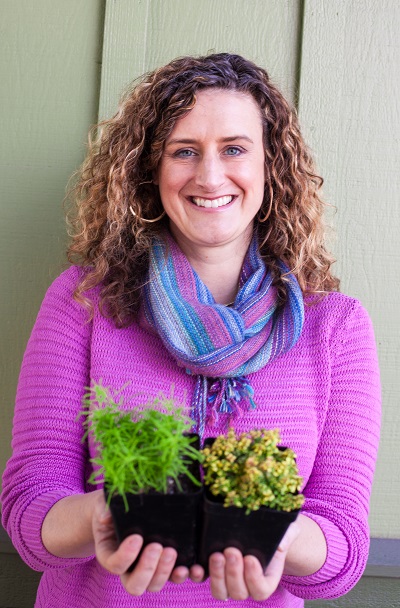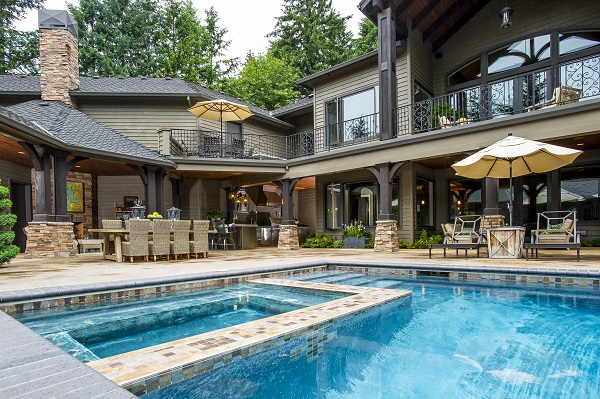Traditional Country Farmhouse Meets Modern Industrial Chateau
When Greg and Lisa Waggoner began plans to remodel their house, they knew they wanted their home to be a harmonious blend between rustic country style and industrial modern chic. Greg had worked for years as a graphic designer at a manufacturing company, and Lisa had an interior design degree from Marylhurst University—relevant backgrounds to make it happen. To bring their vision to life, the Waggoners teamed up with architect Diane Foreman of Neil Kelly Architecture.
“Initially they had some trouble finding designers familiar with the look they wanted,” says Foreman. Yet she could envision the two seemingly disparate styles coming together. “We began collaborating. They’re very, very creative people,” she says. With the three designers working together, the juices started flowing. Their crowning achievement would be the kitchen redesign.
In this complete remodel, the kitchen was easily the most appealing, but challenging. “I wanted something that expressed our personality and looked lived in,” says Lisa. It successfully unites the two seemingly opposite styles: industrial and country. The traditional country style takes the form of muted white cabinets, blue-grey walls and ceramic subway tiles. The hand-scraped and distressed walnut flooring adds country flavor as well. Alternately, the stainless steel appliances and bare hung lighting seep into a more industrial look. With a pop of strawberry red inspired by an old Coca-Cola sign, the rolling countertop is an engaging industrial element. For easy rearranging, the red countertop locks into place, yet is detachable. Lisa’s artwork and her collection of antique cameras are displayed on shelves, adding an eclectic flair to the industrial country hybrid.
The team went out of their way to recycle and reuse old materials while bringing in new sustainable materials and services. “One thing that we did was to take a look at the carbon footprint and use only local people,” Foreman notes.
The kitchen countertop, built by Ron Lucas of Platinum Forge, was made out of masticated fly ash concrete and contained 40 percent consumer waste. The trio of designers decided to paint and reuse the old kitchen cabinets in the laundry room and in Greg’s “man-cave” workshop. They selected energy-efficient windows and doors, and water-conserving facets as well. “We wanted to keep it as green as possible and within our budget,” says Lisa.
The final challenge was uniting the back deck with the kitchen. During the summer, the Waggoners practically live out on their deck, entertaining guests indoors and outdoors. In the existing layout, though, the deck was on the other side of a kitchen wall, which stemmed the flow of outdoor living. Walls sometimes make better windows, especially those you can walk through. Three-panel French sliding doors seamlessly bridged the kitchen and outdoor dining. Barbequing is now easier along a twelve-foot galley countertop, with an adjacent sink and prep area.
Ultimately the Waggoners are content with having pulled together two conflicting design styles and extending their kitchen to the outdoors. This finished remodel recently won a prestigious regional award for sustainability from the National Association of the Remodeling Industry.
Japanese Zen Meets Texas Swagger
Since 1990, Bob Burton has worked as an artist manager and public relations agent for Hollywood clients like Neil Patrick Harris of “How I Met Your Mother,” and Pat Sajak, host of “Wheel of Fortune.” In his early days fresh from University of Texas, with a degree in marketing, he worked for several years in the real estate and construction business.
In 2002, Burton, and his wife, Lenna, bought a 2,000-square-foot historic house in Ashland. Burton rented it for nine years before he decided to do a complete remodel and move in. Since he already had experience in the construction industry, he chose to serve as the general contractor for the job. “I knew exactly what I wanted,” says Burton, so he strapped on his toolbelt, picked up a hammer, and got to work remodeling the residence, with the help of designer Mike McKee and builder Scott Larson.
To start with, Burton completely gutted the house to the foundation walls and the rafters. While removing interior walls, he found a stash of newspapers from the 1890s along with an antique, but fully functioning, harmonica.
Designing the house, Burton strove to keep the project sustainable and cost effective. The original house had absolutely nothing sustainable about it, he notes. “I’m a big supporter of green building,” says Burton, “It’s the responsible thing to do if you’re building—to make as green a statement as possible.”
Burton looked to the City of Seattle for its sustainable building checklist. He, Larson and McKee followed the guide closely. Burton bought local products and hired local craftsmen. He also used a geothermal heat pump to warm and cool the house. Geothermal heating uses the heat stored in the Earth’s crust to warm during winter, then pumps cooler ground temperatures into the house during the summer. Burton discovered that after federal tax credits, geothermal heating proved to be as costefficient as traditional heating over the long run.
Burton also chose energy-efficient windows, Energy Star Electrolux appliances, and low-voltage lighting. He installed a tankless gas water heater for efficient hot water. On the job site, the team recycled all the old building materials that could not be reused.
The kitchen remodel proved to be the highlight of the project. The kitchen style is a blend of Japanese aesthetics and bold Texan. Elsewhere these conflicting styles would be more confusion than fusion. In the kitchen, however, they play well together. “This is the complexity of what he did,” says McKee. “It’s a very cool and eclectic way of dealing with interior finishes.”
The cabinets, custom-built by Roelke Cabinets in neighboring Jacksonville, take on a deep walnut veneer. A black Cambrian granite countertop, a curved island inlaid with glass tiles is illuminated by pinpoint halogen lighting. Over the sink, a row of windows overlook the beautiful Grizzly Peak in the Cascades. Burton and his wife travel a lot, so they wanted a kitchen that reflected the same hotel-bar experience they are comfortable with. “It’s my favorite part of the house—sitting at the bar, eating or drinking, and all with a nice view,” observes Burton.
With Burton as the general contractor, the entire home remodel was accomplished in a mere fourteen months. Burton, McKee and Larson are all pleased with the results. McKee, the designer, was incredulous that a Texan could create a Japanese-inspired remodel. “That’s not easy, and they pulled it off,” McKee says.
Finishing Touches: Bring out your inner salvage
Victorian Hand Carved Pantry Door
Store your kitchen goods behind these hand-carved pantry doors, $595. We discovered them at Aurora Mills Architectural Salvage (auroramills.com), Aurora.
Hermosa Chandelier
Light your dining room with the Hermosa Renaissance Revival Panel-shade chandelier and create a warm, 1920s-style ambience for $776. (rejuvenation.com)
Reclaimed Wood Flooring
Wood floors work well with most design concepts, making them an alluring option for a lot of home decorators. For restored wood, go to Barnwood Naturals, LLC (barnwoodnaturals.com) in Salem or Wood is Wonderful (woodiswonderful.us) in Sheridan.
Runnar Bench
We uncovered this striking bench at ReFind Furniture Shop in Portland. Known as Runnar, it’s made from 100 percent locally relaimed Douglas fir and would accent any ranch- or country-style home. The price tag is $385. (refindfurniture.org)
Rebootle’s Glassware Line
You can jazz up any home with a glass jar or vase, creating color and variety by adding flowers, seashells or even polished rocks. Try i with Rebootle (rebootle.weebly.com) in Forest Grove—a family-owned business that reclaims wine bottles from Oregon’s wine country and transforms them into glassware. Running from $4-$6 each, choose between tall or small sizes in this glassware line.
What’s Hot in Kitchen Remodels?
Melody Emerick, President of Emerick Architects
What’s new and interesting in kitchens, especially cabinets?
Industrial is a big trend. People are using more reclaimed mate rials to get a particular patina. Clients don’t want heavy looking kitchens, so we are using little, if any, upper cabinets and more open shelves, industrial detailing with an almost apothecary and hutch-type feel. As far as colors, people are really responding to a more monochromatic kitchen that is light with some dark detailing, like walnut countertops, marble tile or dark bronze hardware. Warm hardware details are starting to come back with brass and bronze, too.
For sustainable choices, we’re seeing consumers buying FSC cer tified woods, man-made countertops such as Caesarstone and reclaimed materials. They’re shifting to more oil and wax finish and low-VOC paints-more natural finishes for cabinets and floors. Obviously energy efficient appliances are also a big part of that equation. They are also wanting to support more local crafts people and businesses.
What are people looking for these days in lighting?
Natural daylight with big windows to the outside and easy access to an outside dining area is always important. We see people looking for good lighting, yet they don’t want to see a lot of recessed lights. They want it to have more of a seamless feeling that blends with the rest of the rooms. Along those lines, look for overall ambient lighting that is more discreet. Then add a couple statement pieces over an island or a nook.
If you were remodeling your kitchen today, what would you buy?
We just finished building a LEED certified house a few years ago with some favorite choices. Here are some of those: formaldehyde free cabinets, FSC certified wood doors, Oregon white oak floors, a salvaged walnut wood butcher block, Caesarstone countertops and huge double-hung windows for daylight and ventilation.










Your slide shows are too fast and there doesn't seem to be an opportunity to view larger versions of the lovely photos. Please let us linger over the images and examine the details!